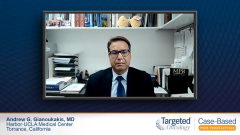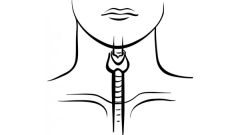
Recommendations for Treating Patients With DTC
Episodes in this series

Andrew G. Gianoukakis, MD: This patient has received appropriate first-line therapy in terms of having had appropriate surgery and radioactive iodine therapy. Those options have been exhausted. Her disease is now radioiodine refractory and primarily in her lungs—although there could be occult lesions elsewhere that have not been discovered clinically as of yet. The lung lesions, however, are small and are not interfering with the patient’s well-being. The patient remains asymptomatic, likely going about her daily routine without a care for her thyroid cancer.
In terms of second-line therapy, we have options for treating patients who have localized disease with radiotherapy. This is not appropriate in this patient as her disease is systemic and throughout the lungs. Additional surgery can be considered for patients with localized disease. Again, not appropriate in this patient as she has diffuse lung disease. This is where we begin to consider systemic therapy for patients.
This patient has diffuse lung disease and is radioiodine refractory. However, the lesions are still small. They are not critical lesions, which require an immediate intervention. The approved systemic therapies in this situation are sorafenib and lenvatinib. While both are effective, neither one is a cure, and both are associated with significant [adverse] effects that may interfere with this patient’s daily sense of well-being. Given that none of the lesions are critical, she remains asymptomatic, and these medications do not offer a cure but control of the disease, it would be appropriate to continue following this patient over time and assessing for disease progression with anatomic scanning, such as CT scans, and thyroglobulin measurements. Depending on the degree and rapidity of disease progression noted by thyroglobulin measurements and CT scans, one can consider systemic therapy, even in a patient who is now in her mid-to-late 70s.
Transcript edited for clarity.
Case: A 73-Year-Old Woman With Differentiated Thyroid Cancer
Initial Presentation
- A 73-year-old woman complains of a “lump” on her neck, with occasional swelling and dysphagia
- PMH: obese; BMI 32
- PE: palpable, nontender neck mass
Clinical Work-up and Initial Treatment
- Labs: TSH 1.1 µU/mL; all others WNL
- Ultrasound of the neck revealed a 3.0 cm mass in the right lobe of the thyroid; several suspicious lymph nodes ranging from 0.2-3.0 cm in size
- Ultrasound-guided FNAB: confirmed papillary thyroid carcinoma
- Patient underwent total thyroidectomy with bilateral central neck dissection
- Pathology: 3.0 cm papillary thyroid cancer arising in right lobe of the thyroid, 2 of 5 positive central compartment lymph nodes, largest 1.4 cm, positive extra nodal extension
- StageT2N1MX; ECOG PS 0
Subsequent Treatment and Follow-up
- She was treated with radioactive iodine
- Levothyroxine to suppression was added to treatment regimen
- Follow-up at 6 months TSH 0.4 µU/mL, thyroglobulin 4 ng/mL
- Neck US unremarkable
- Follow-up 12 months TSH 0.3 µU/mL, thyroglobulin 18 ng/mL
- US of the neck was unremarkable
- CT of the chest showed 10 lung nodules, largest 1.2 cm in size
- Administered radioactive iodine 150 millicuries
- Post therapy scan showed no lung or other uptake
- Follow-up at 2 years TSH 0.3 µU/mL, thyroglobulin 30 ng/mL
- Chest CT increasing number and size of lung nodules; largest 1.6 cm
- Patient was asymptomatic and deemed radioactive iodine refractory
- Systemic therapy with lenvatinib 24 mg PO qDay considered









































